Let's talk French Bulldogs
Stocky and chock full of personality, French Bulldogs make fantastic companions. Their compact size and determination has won the hearts of many a potential owner. Don’t be fooled by that serious look on their face: there’s usually a playful dog hidden within. The French Bulldog is an adaptable breed that just wants to have fun. Bonus round: They are known to be easygoing with children—really everyone—and especially other dogs and pets.
Official name: French Bulldog
Other names: Frenchie
Origins: England, France
Drooling tendencies
1 out of 5Grooming needs
1 out of 5Shedding Level
3 out of 5Barking tendencies
2 out of 5Energy level*
3 out of 5Compatibility with other pets
5 out of 5Warm weather?
1 out of 5Cold weather?
2 out of 5Suited to apartment living
5 out of 5Can stay alone
1 out of 5Family pet?*
5 out of 5
| Male | Female |
|---|---|
| Height | Height |
| 27 - 34 cm | 24 - 32 cm |
| Weight | Weight |
| 9 - 14 kg | 8 - 13 kg |
| Life Stage | |
|---|---|
| Puppy | Adult |
| 2 to 10 months | 10 months to 8 years |
| Mature | Senior |
| 8 years to 12 years | From 12 years |
Drooling tendencies
1 out of 5Grooming needs
1 out of 5Shedding Level
3 out of 5Barking tendencies
2 out of 5Energy level*
3 out of 5Compatibility with other pets
5 out of 5Warm weather?
1 out of 5Cold weather?
2 out of 5Suited to apartment living
5 out of 5Can stay alone
1 out of 5Family pet?*
5 out of 5
| Male | Female |
|---|---|
| Height | Height |
| 27 - 34 cm | 24 - 32 cm |
| Weight | Weight |
| 9 - 14 kg | 8 - 13 kg |
| Life Stage | |
|---|---|
| Puppy | Adult |
| 2 to 10 months | 10 months to 8 years |
| Mature | Senior |
| 8 years to 12 years | From 12 years |
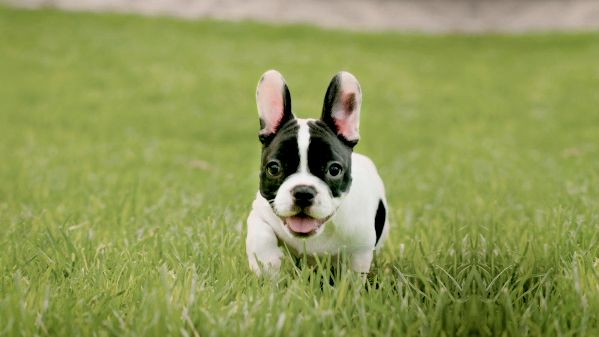
Get to know the French Bulldog
All you need to know about the breed
The French Bulldog! The darling of Paris has turned the world on its ear and become one of the most popular breeds. They are seventh on the U.K. Kennel Club’s latest rankings, and fourth on those of the American Kennel Club. Their small size makes the French Bulldog a model canine for city dwellers but it’s their affable manner that has made them a universally cherished breed.
Truth be told, the French Bulldog is a really good pet, especially for first-time owners. They’re content just napping by your side (one of their favorite activities), or playing the day away, and are as much at ease with small humans, once trained, as they are with large ones.
The breed’s striking bat-like ears combined with their “grumpy” face are the exact opposite of their jovial personality. When in their presence, you can watch the comedy routine unfold: French Bulldogs are prone to antics.
All joking aside, obedience training for the French Bulldog isn’t a bad idea. Socialization will be necessary since the breed can be very bonded to their owner. It’s really the French Bulldog’s petite size more than anything that makes them a tad dependent on a strong partnership. This is not a dog to be used for rescue or guarding; companionship is their best attribute.

2 facts about French Bulldogs
1. Cute but hefty
It’s easy to view your French Bulldog as an adorable companion but that stocky body is something to think about: It means exercise should be adapted to the dog’s ability, and swimming is definitely not allowed, as their density means they have little to no buoyancy. Stick to good feeding habits so your French Bulldog doesn’t gain weight.
2. Watch for them to be wiley
Enjoyable to watch, French Bulldog behavior requires a backdrop of discipline. They’re playful for sure, but great fun can soon turn into willful ways—or even disobedience. They can even at times be called clownish. Offer them reward-based training—meaning treats—with each request. Just ensure treats are taken from their daily food portion!
History of the breed
The French Bulldog history is a long and fascinating one. The breed is thought to have descended from dogs used by the Molossians, an ancient Greek tribe that eventually made its way to England. The Molossian dog is then said to have developed into the English Mastiff and their sub-breed, the Bullenbeisser. After being initially used for the sport of bullbaiting, the breed became more of a companion dog after the sport was rightfully outlawed in 1835.
Terriers, who were found widely in England, were then crossed with the French Bulldog’s ancestor to achieve a mini version or toy Bulldog, where it continued to function as a ratter and guard dog. The early French Bulldog breed became very popular in the central England region of Nottingham, particularly in the lacemaking industry, where they were valued for their ability to chase down rodents.
By the 1860s, this new type of French Bulldog breed debuted in dog shows in the country and became very popular. When the lacemaking industry shifted to France following a dip in popularity in England, lacemakers moved to Normandy and brought their dogs with them.
The French Bulldog caught on hugely in the nation, gradually becoming the breed we know today. The dog was highly fashionable and popular with society, particularly the royalty and nobility. They were incredibly celebrated in Paris, and seen widely in cafe life there. The famous French artists Toulouse-Lautrec and Degas often depicted French Bulldogs in their paintings.
The breed gained equal popularity in America in the 20th Century. They were recognized by the American Kennel Club in 1898 and The Kennel Club in England in 1905.
From head to tail
Physical characteristics of French Bulldogs
1.Ears
2.Head
3.Body
4.Tail
5.Fur
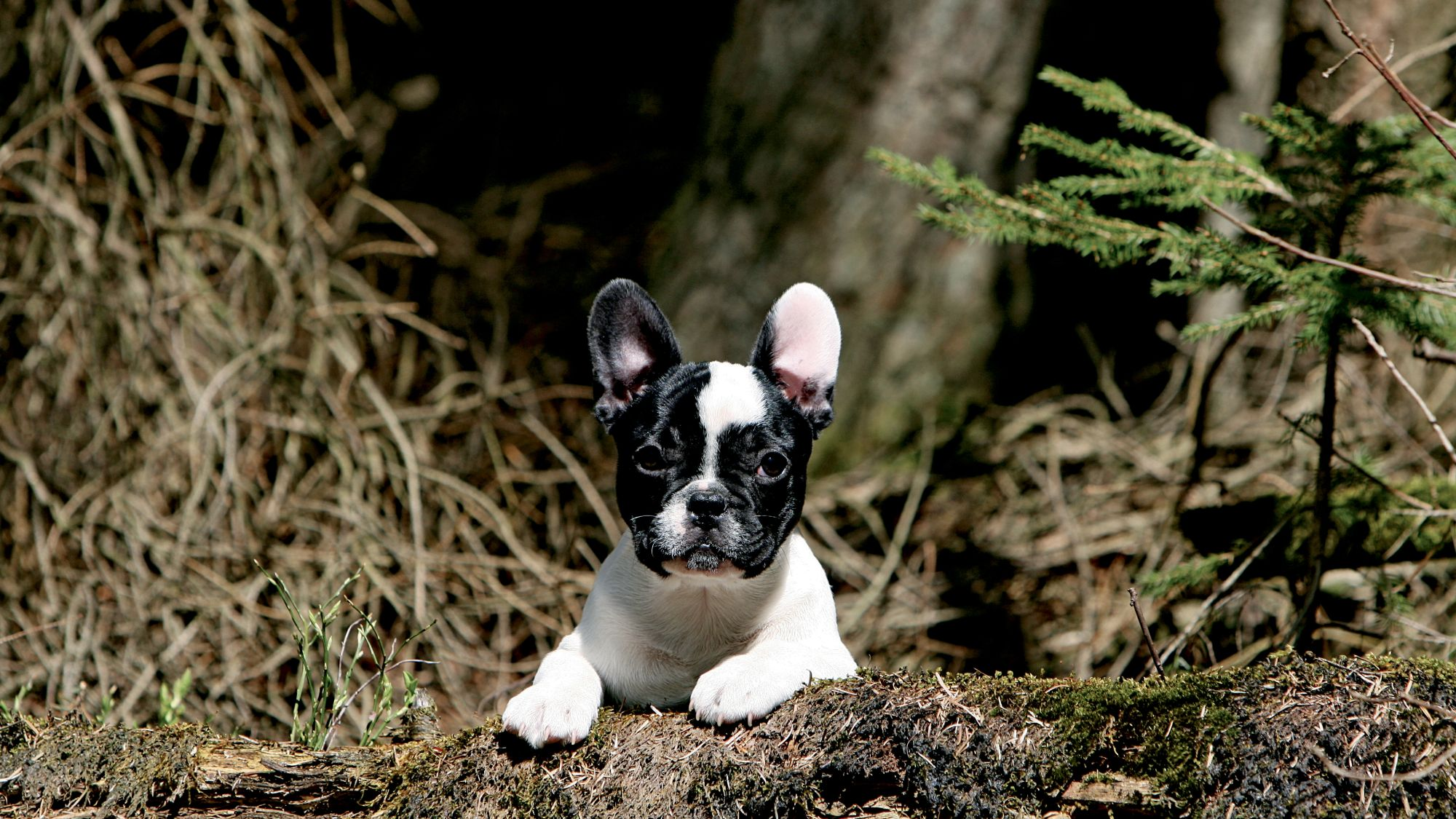
Things to look out for
From specific breed traits to a general health overview, here are some interesting facts about your French Bulldog
That cute face may be problematic
French Bulldogs health issues are minimal but their facial structure can pose problems when it comes to breathing. French Bulldogs are prone to respiratory problems due to their facial makeup, i.e. brachycephalic syndrome, characterized by a flattened snout and nostrils. Breathing difficulties—especially in too-hot or too-cold weather—can be common, as when their exercise session is too strenuous. Take caution in very hot or cold weather. No dog should ever be in a hot car, only in air-conditioned places. They also have frequent digestive problems: Many dogs that have brachycephalic airway obstruction syndrome also show signs of gastrointestinal distress.
A robust body that’s prone to obesity
The stocky body of the French Bulldog couldn’t be more endearing but it needs to be kept slim and trim, too. The breed could easily gain weight if meals and snacks aren’t kept in check. Their heavy chest and substantial legs make for a sturdy muscular build, but their small size demands almost more scrutiny than their big brethren. And they can’t take dips in the ocean, lake, or pool unless it’s with you holding them tight: They are barrel-like, so they often “roll” instead of swim, their very dense body lacking the buoyancy they need to get through the water. Keep them on dry land for their best exercise routine.
May suffer from cherry eye
It’s not life-threatening, it just looks bad: Cherry eye. The condition happens in French Bulldogs when the tear gland of the third eyelid (which all dogs have) pops out of place. The eye then looks slightly bulging, and is lined in red on the outer rim. Cherry eye happens when the fibers that anchor the gland inside the third eyelid become weak. There’s no avoiding it: Keep a close eye (!) on your dog for any sign of the condition. If it happens, treat your French Bulldog quickly at the veterinarian. When looking to add a new dog to your household, make sure to deal only with a responsible breeder.
Healthy diet, healthier dog
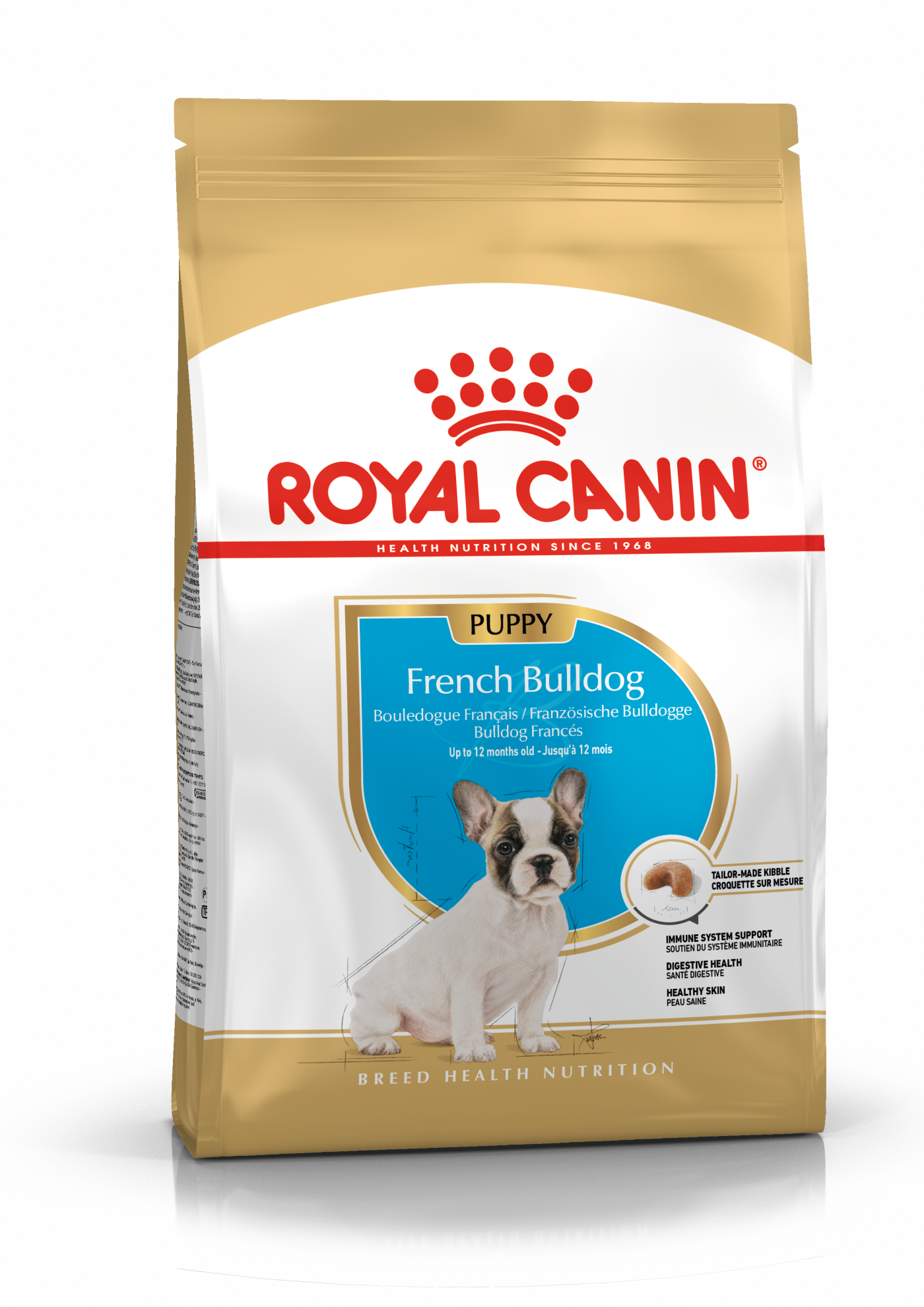
When choosing food for a French Bulldog, there are many factors to consider: their age, lifestyle, activity level, physiological condition and health including potential sickness or sensitivities. Food provides energy to cover a dog’s vital functions, and a complete nutritional formula should contain an adjusted balance of nutrients to avoid any deficiency or excess in their diet, both of which could have adverse effects on the dog.
Clean and fresh water should be available at all times to support good urinary regularity. In hot weather and especially when out exercising, bring water along for your dog’s frequent water breaks.
Energy intake will always have to be adapted to the climatic conditions. A dog that lives outdoors in winter will have increased energy requirements.
The following recommendations are for healthy animals. If your dog has health problems, please consult your veterinarian who will prescribe an exclusive veterinary diet.
A French Bulldog puppy’s requirements, in terms of energy, protein, minerals and vitamins, are much greater than those of an adult dog. They need energy and nutrients to maintain their body, as well as to grow and build new cells. Until they are 12 months old, French Bulldog puppies’ immune systems develop gradually. A complex of antioxidants – including vitaminE – can help support their natural defences during this time of big changes, discoveries and new encounters. Their digestive functions are different from an adult French Bulldog’s, too: their digestive system is not mature yet so it’s important to provide highly digestible proteins that will be effectively used. Prebiotics, such as fructo-oligosaccharides, support digestive health by helping to balance intestinal flora, resulting in good stool quality.
The brachycephalic nature of the French bulldog is an important factor that needs to be taken into account when choosing the size, shape and texture of kibble to make it easier for them to pick up and to encourage chewing. A dog’s skin and coat reflect their state of health, and the maintenance of the health of a French Bulldog's skin and coat requires nutrients like omega-3 fatty acids (EPA-DHA), essential amino acids and B vitamins to reinforce the 'barrier' function of the skin. This short growth phase also means high energy needs, so the food must have a high energy content (expressed in Kcal/100g of food), while concentrations of all other nutrients will also be higher than normal in a specially formulated growth food. It is recommended to split the daily allowance into three meals until they are six months old, then to switch to two meals per day.
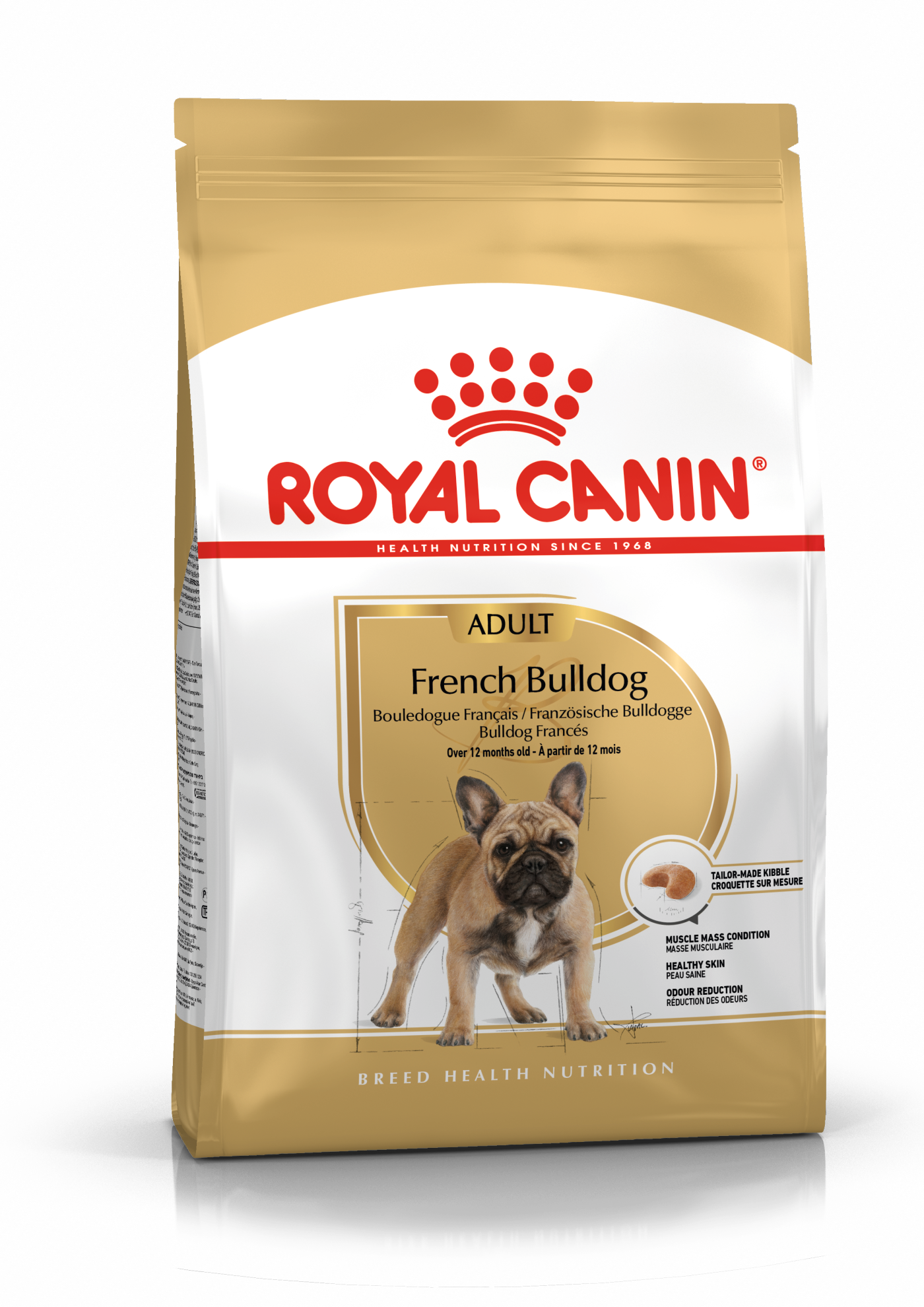
The main nutritional goals for adult French Bulldogs are:
Maintaining the French Bulldog’s muscle mass with optimal protein content and L-carnitine to promote fat burning
Preserving the health and beauty of the skin and coat with the enriched addition of essential fatty acids (especially EPA-DHA), essential amino acids and B vitamins
Promoting optimal digestibility with high quality protein and a balanced supply of dietary fibre in order to reduce intestinal fermentation, which may cause digestive disorders, flatulence and bad stool odour.
To help support their natural defences, a formula enriched with an antioxidant complex and containing mannan-oligosaccharides is recommended.

After 7 years old, French Bulldogs start facing the first signs of ageing. A formula enriched with antioxidants will help maintain their vitality, and specific nutrients, such as chondroitin and glucosamine, will help maintain healthy bones and joints. Ageing is also accompanied by the modification of digestive capacities and particular nutritional requirements, so food for older French Bulldogs should have the following characteristics:
Higher vitamin C and E content. These nutrients have antioxidant properties, helping to protect the body’s cells against the harmful effects of the oxidative stress linked to ageing.
High-quality protein. Contrary to a widely held misconception, lowering the protein content in food brings little benefit in limiting kidney failure. In addition, older dogs are less efficient at using dietary protein than younger dogs. Reducing the phosphorus content is a good way of slowing down the gradual deterioration of kidney function.
A higher proportion of the trace elements iron, zinc and manganese to help to keep the skin and coat in good condition
A higher quantity of polyunsaturated fatty acids, like borage oil and fish oil, to maintain the quality of the coat. Dogs can normally produce these fatty acids but ageing can affect this physiological process.
As they age, dogs increasingly suffer from teeth problems. To ensure they continue to eat in sufficient quantities, the shape, size, and hardness of their kibble needs to be tailored to their jaw.
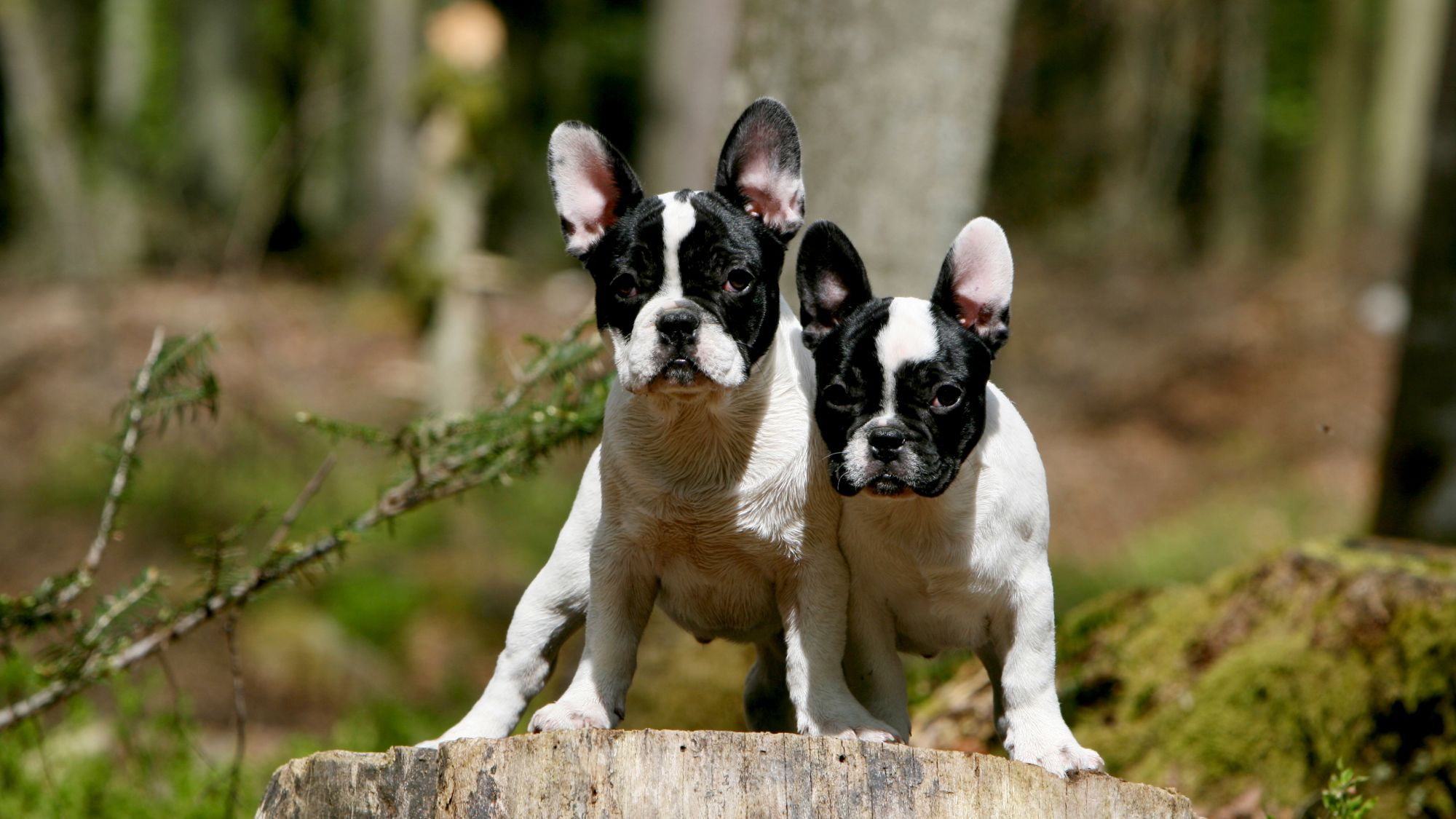
Caring for your French Bulldog
Grooming, training and exercise tips
When it comes to exercise, the French Bulldog doesn’t need a huge amount to keep healthy. Daily walks are sufficient, and they love to play around the house or yard. Bulldogs do not cope well in the heat however, so exercise should be moderate in the summer. Games that test their brain also benefit the very smart French Bulldog, who never shrinks from a challenge.
Their short-haired coat is one of their more attractive characteristics but shedding for the French Bulldog does happen. They’ll benefit from weekly brushing with a medium-bristle brush or rubber grooming glove. The wrinkles and folds in their face should be kept clean and dry as well, to prevent bacteria buildup. Bathe your Frenchie monthly (or on an as-needed basis) and make sure to dry the folds of the skin completely afterward. Trimming their nails on a weekly basis too will keep their sturdy body in balance.
One of the best traits of the French Bulldog is their intelligence. It’s important to be firm from puppyhood since the French Bulldog can be willful when they want to be. Patience is key too, and commands may need to be repeated during the training process. The breed is easy to train, and responds well to reward-based commands—meaning a treat is at the end of that “Sit!” A treat can be anything that your pet enjoys—dry food, treats, attention or petting, a fun toy, a play session. It’s important to limit the use of food-based treats since they can contribute to excessive weight gain. If they’ve had treats during the day, adjust your dog’s daily food portion accordingly.
When it comes to exercise, the French Bulldog doesn’t need a huge amount to keep healthy. Daily walks are sufficient, and they love to play around the house or yard. Bulldogs do not cope well in the heat however, so exercise should be moderate in the summer. Games that test their brain also benefit the very smart French Bulldog, who never shrinks from a challenge.
Their short-haired coat is one of their more attractive characteristics but shedding for the French Bulldog does happen. They’ll benefit from weekly brushing with a medium-bristle brush or rubber grooming glove. The wrinkles and folds in their face should be kept clean and dry as well, to prevent bacteria buildup. Bathe your Frenchie monthly (or on an as-needed basis) and make sure to dry the folds of the skin completely afterward. Trimming their nails on a weekly basis too will keep their sturdy body in balance.
One of the best traits of the French Bulldog is their intelligence. It’s important to be firm from puppyhood since the French Bulldog can be willful when they want to be. Patience is key too, and commands may need to be repeated during the training process. The breed is easy to train, and responds well to reward-based commands—meaning a treat is at the end of that “Sit!” A treat can be anything that your pet enjoys—dry food, treats, attention or petting, a fun toy, a play session. It’s important to limit the use of food-based treats since they can contribute to excessive weight gain. If they’ve had treats during the day, adjust your dog’s daily food portion accordingly.
All about French Bulldogs
A very popular breed, the French Bulldog makes an excellent pet and companion dog, for families or single people, city and country folk alike. Affectionate, low-key, and well-balanced, this incredible breed is valued for their affable approach to life. They’re always up for a nice walk but like their downtime, too.
Pleasant by nature, the French Bulldog breed is known to be curious, playful, and funny. Some are more energetic than others, but the one thing they have in common is the love of a good time!
Read more about breeds
Sources
- Veterinary Centers of America https://vcahospitals.com/
- Royal Canin Dog Encyclopaedia. Ed 2010 e 2020
- Banfield Pet Hospital https://www.banfield.com/
- Royal Canin BHN Product Book
- American Kennel Club https://www.akc.org/
Like & share this page